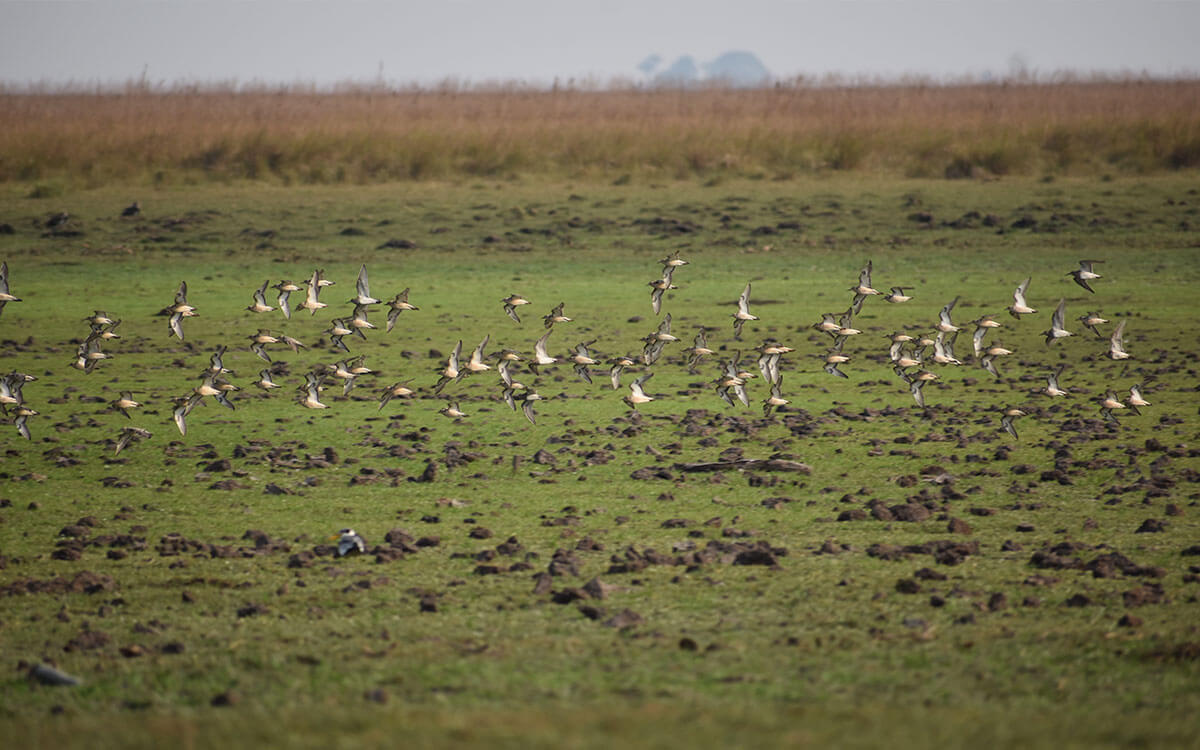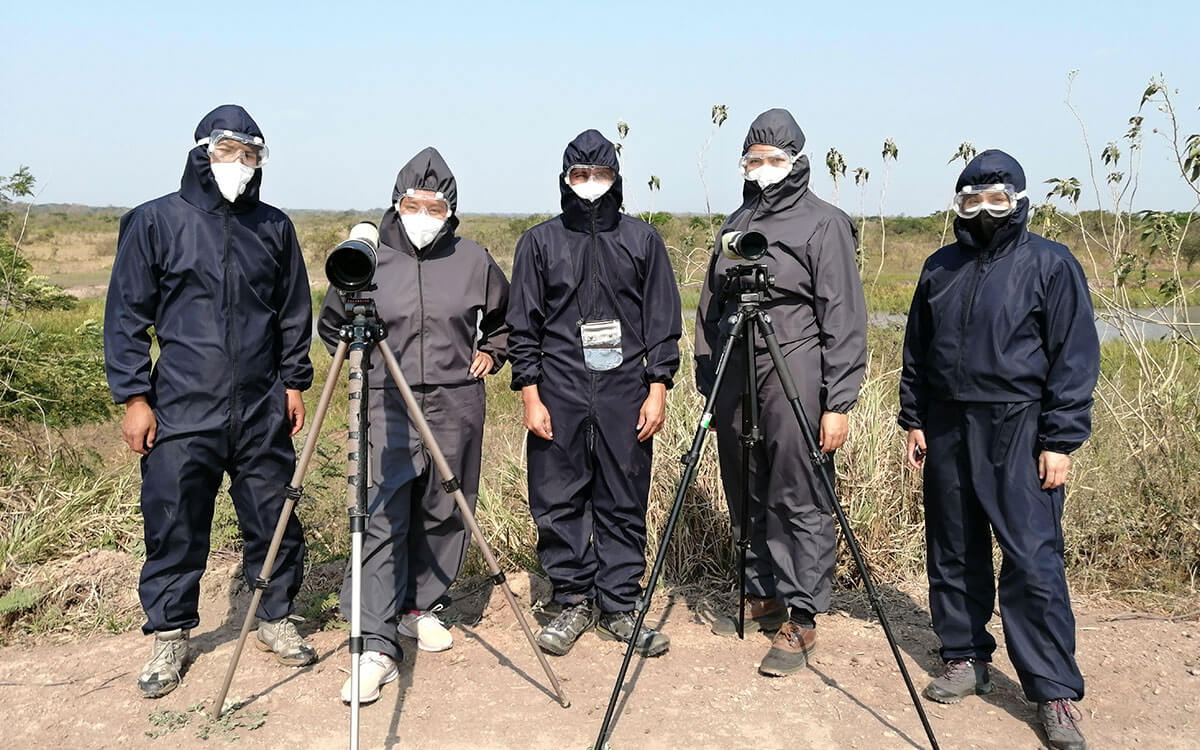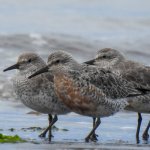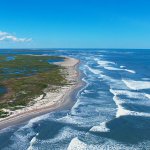By Tjalle Boorsma – Asociación Armonía
The Bolivian dry season has arrived in the Beni savanna locally known as the Llanos de Moxos. Eight months of flooding (November-July) is taken over by 4 months of extreme drought (July-November). This is also the time for Buff-breasted Sandpipers (Calidris subruficollis) and other shorebirds to arrive on these Bolivian natural grasslands to feed, rest and prepare for their final stretch of southbound migration to reach their winter grounds.
Asociación Armonia, Bolivia’s leading bird conservation NGO, created in 2008 the Barba Azul Nature Reserve deep in the heart of the Llanos de Moxos. At Barba Azul, Armonia is protecting key habitat for the endemic Blue-throated Macaw but they have also found large numbers of shorebirds using river-edge shortgrass in September including Buff-breasted Sandpipers. Due to the large numbers of Buff-breasted Sandpipers using Barba Azul as critical stopover habitat, the reserve was declared a WHSRN site of Regional Importance in 2015. Through the support from the US Fish and Wildlife Service’s Neotropical Migratory Bird Conservation Act (NMBCA) program, Armonía started monitoring shorebirds systematically since 2014 and is now managing a database of 7 years of shorebird migration data in the Barba Azul Nature Reserve.
Barba Azul Nature Reserve is only 11,000 hectares while the Llanos de Moxos is approximately 12 million hectares of a complex mosaic of treeless grasslands, cerrado-like savanna, palm savanna, palm forest islands, gallery forest along white-water rivers, herbaceous wetlands and shallow lakes.
In 2016, a total of 1,460 Buff-breasted Sandpipers (2.5% of the species global population) were observed in a single day in Barba Azul. But many more Buff-breasted Sandpipers are using the entire Llanos de Moxos for their Southbound migration. Additionally apart from the ‘buffies’, large numbers of Pectoral Sandpipers (Calidris melanotos), Upland Sandpipers (Bartramia longicauda) and to a lesser extent the American Golden-Plover (Pluvialis dominica) use this ecoregion during their southbound migration (Herzog et. al. unpublished data).

The Buff-breasted Sandpipers uses the Llanos de Moxos only during their southbound migration. This is because The Llanos de Moxos in September provides sufficient foraging habitat. On their northbound migration, the Llanos de Moxos is completely flooded and little foraging habitat is available. Therefore, they skip Bolivia and fly straight to the Llanos of Colombia and Venezuela that are in the dry season at that specific time. Photo: Teo Camacho
Armonía’s shorebird monitoring team traveled to Barba Azul on the 28th of August to survey long-distance migratory shorebirds for 30 days at five different locations within the reserve. The team gathered data on presence/absence of shorebirds, but also other environmental factors to better understand shorebird foraging preference at specific sites (grass lengths, presence/absence of livestock, number of dung piles, distance to forest, grass cover, etc). Preliminary results showed day counts ranging from 15 (minimum) to 322 (maximum) Buff-breasted Sandpipers individuals.
Unfortunately, new land-use reform laws have been approved in 2019 to convert 83% of natural grasslands and marsh habitat to soya and rice fields in the Llanos de Moxos, threatening natural foraging habitat for long distance migratory shorebirds. Therefore, it is urgent to understand habitat use and selection by Buff-breasted Sandpipers in this natural grassland system and evaluate priority stopover areas.
Armonía is pushing landscape-scale conservation way beyond the borders of only our Blue-throated Macaw reserves. Threatened species like the Blue-throated Macaw and Buff-breasted Sandpiper share habitat with private cattle ranchers, the most important economy of this region and therefore the most important stakeholder. The creation of protected reserves conserving key habitat is an important strategy, but more important is developing sustainable development strategies like environmentally friendly ranching to assure much larger landscape-scale conservation.
The conservation strategy is to convince these business-minded stakeholders to adopt sustainable best-practices ranching techniques. This is done by showing hands-on results through the Barba Azul model ranch that Armonia is developing, demonstrating improved productivity and economic revenues, while protecting habitat. Protecting habitat is protecting the financial assets of a ranch. Working together with ranchers is key to the safety of the Llanos de Moxos securing safe stopover habitat for shorebirds.

Field team heading to Barba Azul following COVID security measures. Photo: Teodoro Camacho
Cover Photo: Buff-breasted Sandpipers at Barba Azul. Photo: Daniel Alarcon.






